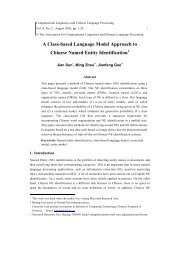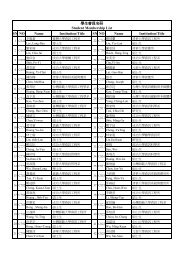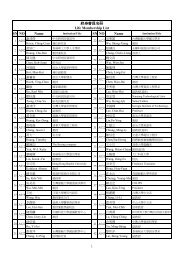Machine Translation Approaches and Survey for Indian ... - aclclp
Machine Translation Approaches and Survey for Indian ... - aclclp
Machine Translation Approaches and Survey for Indian ... - aclclp
You also want an ePaper? Increase the reach of your titles
YUMPU automatically turns print PDFs into web optimized ePapers that Google loves.
50 Antony P. J.to the Apertium system, using a bilingual dictionary <strong>and</strong> a three-staged process, i.e. first anative speaking human editor of the SL (SL) pre-processed the text, then the machineper<strong>for</strong>med the translation, <strong>and</strong> finally a native-speaking human editor of the TL post-edited thetext (Hutchins et al., 1993; Hutchins et al., 2000).After the birth of computers Electrical Numerical Integrator <strong>and</strong> Calculator (ENIAC) in1947, research began on using computers as aids <strong>for</strong> translating natural languages (Hutchins etal., 2005). The first public demonstration of MT in the Georgetown-IBM experiment, whichproved deceptively promising, encouraged financing of further research in the field. In 1949,Weaver wrote a memor<strong>and</strong>um, putting <strong>for</strong>ward various proposals (based on the wartimesuccesses in code breaking) on the developments in in<strong>for</strong>mation theory <strong>and</strong> speculation aboutuniversal principles underlying natural languages (Weaver et al., 1999). In the decade ofoptimism, from 1954-1966, researchers encountered many predictions ofimminent ’breakthroughs’. In 1966, the Automated Language Processing Advisory Committee(ALPAC) report was submitted, which said that, <strong>for</strong> ’semantic barriers’, there are nostraight<strong>for</strong>ward solutions. The ALPAC report committee could not find any "pressing need <strong>for</strong>MT" nor "an unfulfilled need <strong>for</strong> translation (ALPAC et al., 1996)".This report brought MT research to its knees, suspending virtually all research in theUnited States of America (USA) while some research continued in Canada, France, <strong>and</strong>Germany (Hutchins et al., 2005). After the ALPAC report, MT almost was ignored from1966-1980. In the year 1988, Georgetown-IBM experiment launched “IBM CANDIDESystem,” where over 60 Russian sentences were translated smoothly into English using 6 rules<strong>and</strong> a bilingual dictionary consisting of 250 Russian words, with rule-signs assigned to wordswith more than one meaning. Although Professor Leon Dostert cautioned that thisexperimental demonstration was only a scientific sample, or "a Kitty Hawk of electronictranslation (Kitty Hawk 1 )," a wide variety of MT systems emerged after 1980 from variouscountries <strong>and</strong> research continued on more advanced methods <strong>and</strong> techniques. Those systemsmostly were comprised of indirect translations or used an ’interlingua’ as an intermediary. Inthe 1990s, Statistical <strong>Machine</strong> <strong>Translation</strong> (SMT) <strong>and</strong> what is now known as Example-based<strong>Machine</strong> <strong>Translation</strong> (EBMT) saw the light of day (IBM, 1954). At this time the focus of MTbegan to shift somewhat from pure research to practical application using a hybrid approach.Moving towards the change of the millennium, MT became more readily available toindividuals via online services <strong>and</strong> software <strong>for</strong> their personal computers.1 Kitty Hawk, North Carolina, USA was the site <strong>for</strong> the world’s first successful powered human flight bythe Wright brothers. "Kitty Hawk" references generally meant a break-through success in its earlystages.









